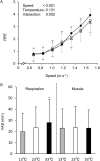Impact of ambient temperature on energy cost and economical speed during level walking in healthy young males
- PMID: 29970478
- PMCID: PMC6078347
- DOI: 10.1242/bio.035121
Impact of ambient temperature on energy cost and economical speed during level walking in healthy young males
Abstract
We measured oxygen consumption and carbon dioxide output during walking [per unit distance (Cw) values] for 14 healthy young human males at seven speeds from 0.67 to 1.67 m s-1 (4 min per stage) in thermoneutral (23°C), cool (13°C), and hot (33°C) environments. The Cw at faster gait speeds in the 33°C trial was slightly higher compared to those in the 23°C and 13°C trials. We found the speed at which the young males walked had a significant effect on the Cw values (P<0.05), but the different environmental temperatures showed no significant effect (P>0.05). Economical speed (ES) which can minimize the Cw in each individual was calculated from a U-shaped relationship. We found a significantly slower ES at 33°C [1.265 (0.060) m s-1 mean (s.d.)] compared to 23°C [1.349 (0.077) m s-1] and 13°C [1.356 (0.078) m s-1, P<0.05, respectively] with no differences between 23°C and 13°C (P>0.05). Heart rate and mean skin temperature responses in the 33°C condition increased throughout the walking trial compared to 23°C and 13°C (all P<0.05). These results suggest that an acutely hot environment slowed the ES by ∼7%, but an acutely cool environment did not affect the Cw and ES.
Keywords: Economical speed; Energy expenditure; Heart rate; Hot environment; Pulmonary ventilation.
© 2018. Published by The Company of Biologists Ltd.
Conflict of interest statement
Competing interestsThe authors declare no competing or financial interests.
Figures

 (A),
(A),  (B),
(B),  (C), and EE (D) at all gait speeds in thermoneutral (○; 23°C), cool (Δ; 13°C), and hot (●; 33°C) conditions. Values are means±standard deviation (s.d.).
(C), and EE (D) at all gait speeds in thermoneutral (○; 23°C), cool (Δ; 13°C), and hot (●; 33°C) conditions. Values are means±standard deviation (s.d.).  oxygen uptake;
oxygen uptake;  , carbon dioxide output;
, carbon dioxide output;  , pulmonary ventilation; EE, energy expenditure. *P<0.05 between 33°C and 13°C, †P<0.05 between 33°C and 23°C.
, pulmonary ventilation; EE, energy expenditure. *P<0.05 between 33°C and 13°C, †P<0.05 between 33°C and 23°C.



Similar articles
-
Combined effects of exposure to hypoxia and cool on walking economy and muscle oxygenation profiles at tibialis anterior.J Sports Sci. 2019 Jul;37(14):1638-1647. doi: 10.1080/02640414.2019.1580130. Epub 2019 Feb 16. J Sports Sci. 2019. PMID: 30774004
-
Walking economy at simulated high altitude in human healthy young male lowlanders.Biol Open. 2016 Oct 15;5(10):1408-1414. doi: 10.1242/bio.019810. Biol Open. 2016. PMID: 27744292 Free PMC article.
-
Economical and preferred walking speed using body weight support apparatus with a spring-like characteristics.BMC Sports Sci Med Rehabil. 2021 Sep 6;13(1):107. doi: 10.1186/s13102-021-00336-7. BMC Sports Sci Med Rehabil. 2021. PMID: 34488873 Free PMC article.
-
Comparisons of energy cost and economical walking speed at various gradients in healthy, active younger and older adults.J Exerc Sci Fit. 2015 Dec;13(2):79-85. doi: 10.1016/j.jesf.2015.06.001. Epub 2015 Aug 25. J Exerc Sci Fit. 2015. PMID: 29541103 Free PMC article.
-
Energy cost and lower leg muscle activities during erect bipedal locomotion under hyperoxia.J Physiol Anthropol. 2018 Jun 19;37(1):18. doi: 10.1186/s40101-018-0177-7. J Physiol Anthropol. 2018. PMID: 29914562 Free PMC article.
Cited by
-
Intra-day variation in daily outdoor walking speed among community-dwelling older adults.BMC Geriatr. 2021 Jul 8;21(1):417. doi: 10.1186/s12877-021-02349-w. BMC Geriatr. 2021. PMID: 34238238 Free PMC article.
-
Reference value on daily living walking parameters among Japanese adults.Geriatr Gerontol Int. 2020 Jul;20(7):664-669. doi: 10.1111/ggi.13931. Epub 2020 May 6. Geriatr Gerontol Int. 2020. PMID: 32378318 Free PMC article.
References
-
- Brouwer E. (1957). On simple formulae for calculating the heat expenditure and the quantities of carbohydrate and fat oxidized in metabolism of men and animals, from gaseous exchange (Oxygen intake and carbonic acid output) and urine-N. Acta Physiol. Pharmacol. Neerl. 6, 795-802. - PubMed
LinkOut - more resources
Full Text Sources
Other Literature Sources

